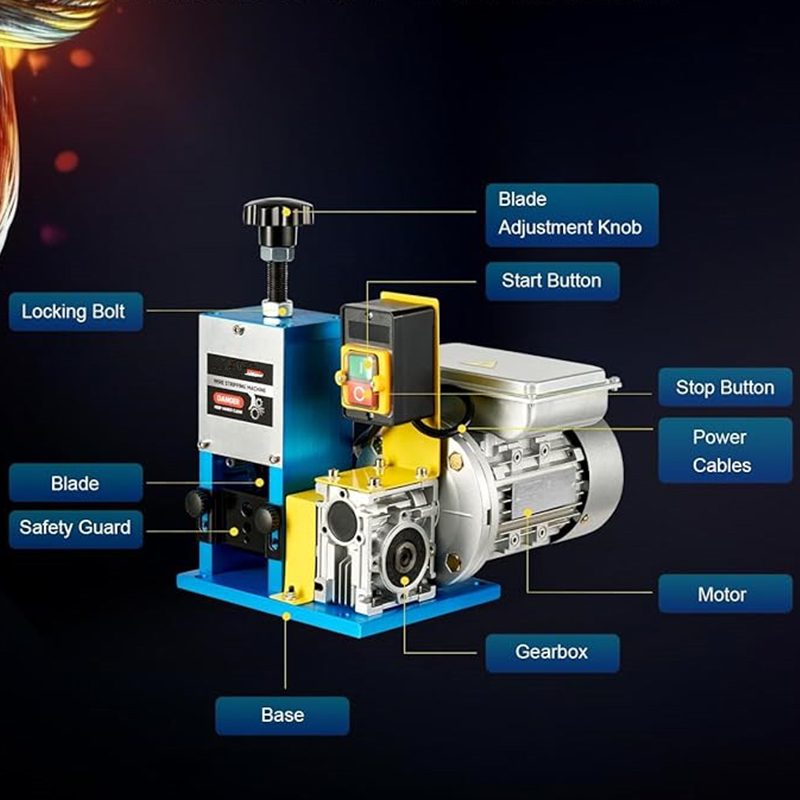How the Vertical Electric Stripping Machine Became a Game-Changer for Complex Wire Processing?
In the fast-evolving world of industrial automation, few challenges are as persistent—and as technically demanding—as the stripping of diverse wire types used across modern manufacturing sectors. Whether in consumer electronics, industrial equipment, or the booming new energy vehicle (NEV) industry, manufacturers face a complex range of wire specifications, materials, diameters, and insulation types.
At the heart of this transformation lies the vertical electric stripping machine—a piece of equipment that, thanks to modular design innovation, is quietly redefining expectations for flexibility and performance on the factory floor.
A New Answer to an Old Problem
Traditional wire stripping machines have long struggled with diversity. Switching between wire types often requires manual reconfiguration or, worse, entirely different machines. In high-mix production environments, this translates to downtime, errors, and inefficiencies.
Enter the vertical electric stripping machine. Instead of being built for a narrow range of wires, its modular architecture allows it to adapt seamlessly to countless wire formats. Need to switch from a shielded coaxial cable to a flat ribbon wire? Or from a single-core automotive wire to a multi-conductor industrial cable? With the vertical electric stripping machine, such transitions can be handled with minimal adjustment and consistent stripping precision.
What sets the vertical electric stripping machine apart is not just its physical design, but the integrated software that drives its performance. Configurable programs allow operators to store wire-specific parameters, reducing setup time and ensuring accuracy regardless of batch variation.
Modular Design: The Quiet Revolution
The term “modular design” is often reserved for smartphones and architecture, but its impact on industrial equipment can’t be overstated. In the case of the vertical electric stripping machine, modularity manifests in tool heads, blade systems, and cable feed units that can be swapped or reconfigured based on task requirements.
This plug-and-play adaptability enables the vertical electric stripping machine to support a wide array of insulation materials—from silicone and Teflon to PVC and XLPE. It can also accommodate changes in stripping length, depth, and rotational speed with ease.
Moreover, vertical design gives the machine a space-saving footprint while providing better gravity-assisted wire handling, which contributes to more stable processing and less mechanical wear. In high-volume applications, this translates to improved durability and consistent output.

Spotlight on the EV Industry: High-Voltage Harnesses
Nowhere is the capability of the vertical electric stripping machine more evident than in the NEV sector. High-voltage harnesses—essential to the safe and efficient functioning of electric vehicles—are among the challenging wire types to process. These cables feature multiple layers of insulation, tight tolerance requirements, and strict quality standards.
In a recent deployment at a Tier 1 automotive supplier, a vertical electric stripping machine was integrated into a production cell dedicated to processing high-voltage orange cables used in electric powertrains. The machine handled varying cable diameters between 2.5 mm² to 120 mm² with a stripping accuracy deviation of less than 0.05 mm.
Operators reported reduced changeover times by over 60%, and the rejection rate for defective strips fell significantly. The vertical electric stripping machine’s automated cable centering and intelligent depth sensing proved crucial in maintaining quality during three-shift operations.
Future-Proofing Through Flexibility
As wire and cable technology continues to advance, driven by trends in miniaturization, data transmission, and electrification, equipment must evolve alongside it. The vertical electric stripping machine is a key example of future-ready automation. Its ability to handle today’s complex requirements while remaining adaptable for tomorrow’s innovations offers peace of mind for manufacturers navigating uncertain demands.
Integrating a vertical electric stripping machine is not just a technical upgrade; it’s a strategic investment. With production lines growing increasingly agile and tailored, the demand for equipment that can flex with them is stronger than ever.
In a world of “a thousand wire types,” the vertical electric stripping machine doesn’t merely keep pace—it sets a new one. Whether on the NEV line or across diversified electronic assembly plants, its modular design continues to prove that flexibility is the new benchmark of industrial success.

 EN
EN  English
English русский
русский Español
Español عربى
عربى









